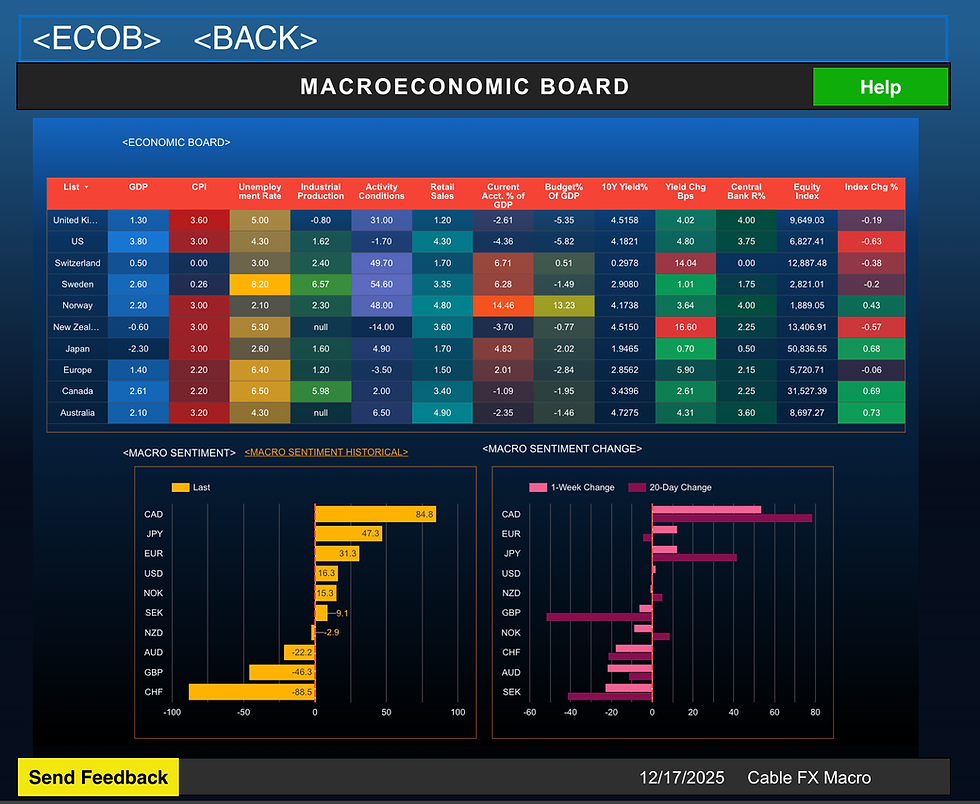🏦🇯🇵Desk Commentary: BoJ March Rate Decision
- Rosbel Durán

- Mar 19, 2024
- 6 min read
UBS:
The headlines tell us that was the first BoJ rate hike For 17 years. The question should really be: is this a different Japan to the one of 17 years ago? Its not certain it is. In fact, it might be worse. Japan's debt/GDP ratio is around 250%f up from about 180% in 2007 and 220% at the beginning of Abenomics in 2013.
Abenomics should have spurred higher economic growth which in turn lifted long-term potential growth; the workforce would expand; foreign companies would be attracted in. The message at the time was that 0.5% GDP growth was simply inadequate for a highly advanced nation. Successfully achieving all this would improve Japan's fiscal position. At the time; Japan was struggling to even meet its public pension liabilities. Inflation of 2% was an output of faster growth; rather than the sole aim. Robin Harding, in the FT, notes that Japan is about to hit the "2025-problem".... "this is the moment when the last of the post-second world war baby boom generation would reach 75, the first of them would become 80, and both their mortality and need for healthcare would start to accelerate". In other words Japan is now about to enter the worst phase of its demographic imbalance.
MUFG:
We are unconvinced that this initial market reaction signals what’s to come. The reality is that the guidance has likely been left purposely vague to provide flexibility. However, Governor Ueda was also clear that upside inflation risks and/or stronger economic data would be enough to indicate additional rate hikes going forward. The BoJ is now essentially data-dependent which is a big change in the BoJ reaction function and opens up the scope for greater FX volatility that should discourage a further build-up of yen carry positions at these weaker yen levels. Import inflation is again picking up and government subsidies that are helping to depress inflation will end on 30th April. Governor Ueda today also stated that the initial Rengo ‘Shunto’ wage increase estimate announced last week (5.28%) was based on a narrow number of unions and the scale that these increases broaden across the economy will be an important determining factor in future rate decisions. Governor Ueda also declined to call the new BoJ policy framework a “Zero Rate Policy” framework suggesting the potential for additional rate hikes going forward.
we see limits to the extent of yen selling that can take place from here. Of course there are greater USD/JPY upside risks over the very short-term given this risk event has now passed without any major hawkish surprise and if the FOMC tomorrow evening was to drop a DOT in its policy rate profile, US yields will likely jump further and potentially drag USD/JPY to intervention levels. But over the medium-term we view today’s announcements as hugely significant that is consistent with higher yields and a stronger yen.
Rabobank:
The BoJ is looking to achieve around a 0.1% increase in the uncollateralised o/n call rate (which is the Japanese equivalent of ESTR).
Previously the BoJ had operated a three tier reserve system for the paying of interest on current account balances. The marginal tier, from the perspective of the o/n call rate, was steered by the policy rate balance which had been set at -0.1%.
The inflation-overshooting commitment regarding the monetary base has ended (this had read “the BoJ will continue expanding the monetary base until the year-on-year rate of increase in the observed CPI (all items less fresh food) exceeds 2% and stays above the target in a stable manner”).
In terms of the market’s reaction to this news, it looks like participants were not generally expecting the ongoing commitment to purchase JGBs in roughly the same amounts as before. We say this because USDJPY has actually weakened in response to the announcement (breaching the 150 mark) while JGB yields are lower and have outperformed swap. In contrast the longer-dated OIS market (from 2yrs out) has remained almost static. Bunds and USTs look to have taken the announcement in their stride, with both yields curves close to unchanged on the day.
Nomura:
The impact of BOJ policy normalization on Asian economies should be limited, especially as change will be gradual. Likely channels are market correlations on FX/rates and portfolio investments. If the BOJ pivot triggers investment repatriation, Australia seems most exposed as it has higher portfolio debt, equity, and bank lending from Japan.
Other countries like Singapore and Indonesia, where Japanese investors hold higher onshore debt, but think spillovers are manageable. As the BOJ lifts rates, most regional peers will likely ease, which could cause currencies to depreciate versus JPY
KRW, SGD and THB are the most sensitive FX in the region to periods of significant JPY appreciation, consistent with their economic trade linkages with Japan. In the long term, we expect to see yen strength versus USD over a multi-quarter period. This is to be driven in part by further tightening by the central bank--potentially in October--but more importantly, the scope for a weaker greenback
Commerzbank:
The end of negative interest rates and yield curve control certainly send out a signal. But the measures are rather homeopathic. After all, the negative interest rate only applied to a small proportion of bank deposits at the BoJ anyway, the overnight call rate will only rise by around 10 basis points and there will be little change to the volume of bond purchases.
It is also unlikely that further massive interest rate hikes will follow. After all, the BoJ is cautious in its outlook: "Given the current economic and price outlook, the Bank expects to maintain accommodative financial conditions for the time being".
This gives the impression that the BoJ wanted to take advantage of a window of opportunity in which inflation is still above the 2% target (and the other central banks are not already cutting interest rates again). It is true that inflation in Japan is also likely to be higher in the future than before the pandemic. However, we are skeptical that the BoJ will achieve its 2% target in the longer term.
Westpac:
There are some who see this as the first step in what could be a game-changer for global bond markets. The question is whether Japanese debt portfolio flows, which have preferenced higher-yielding foreign bonds over local alternatives for the best part of a quarter of a century, begin to slow and reverse. While any such shifts will play out on a much longer timeline than we are currently focusing on, a “regime shift” of that ilk has the potential to push global bond yields higher, all else equal. That has been a topic of interest since the BoJ first tweaked its YCC targets in late 2022, and today’s removal of NIRP and the possibility of higher rates in the future will only accelerate these fears.
The BoJ, perhaps even more than other central banks is expected to take a very cautious approach to any tightening cycle given that previous hopes on that front have been dashed. That is a crucial backdrop to the message of a very measured approach to hikes. So more disruptive policy decisions are sometime in the future. In addition, the BoJ owns 48% of all JGBs and are unlikely to be sellers. In fact the BoJ says its JGB purchases will broadly be the same amount as before, so it is unlikely that 10yr JGB yields shift materially higher on this announcement
ING:
In the short term, it will be important to see whether or not the strong wage growth of large companies spills over to SMEs. The results of the second and third rounds of wage negotiation will be announced on 22 March and 4 April.
From a medium-term perspective, strong wage growth could lead to strong consumption and sustainable consumer prices. We may see the impact of the wage growth in the April/May earnings data. We also expect a big bonus payment before the Golden Week holiday.
In addition to wage data, consumption data should also be watched closely. After all, it is important to see whether or not the impulse of wage growth can change the consumers' spending behaviour. Temporary disruptions of car sales will distort the data through February and March, so the April data onwards should provide us with better information.
As for inflation, it is important to watch not only wage growth but also whether the government fuel subsidy programme will be renewed after May. Inflation staying above 2% by the end of the second quarter of this year will be key to look out for. The April Quarterly Outlook report will hint at an additional rate hike possibility.
TD Securities:
The Japanese yen should rise against the dollar in the longer term as the U.S. currency weakens after the Federal Reserve starts cutting interest rates. We expect a broad weakening in the dollar as the Fed cuts rates starting in 2Q and markets are currently under-priced for that
USD/JPY is now hostage to the FOMC decision tomorrow and any big hawkish surprise from Powell could push USD/JPY beyond its 2022 high at 151.9, this could invoke some strong verbal interventions from Japan's Ministry of Finance




Comments